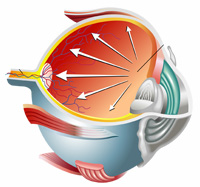About Glaucoma

What Is Glaucoma?
Glaucoma is a process in which several problems occur simultaneously. It’s a multi-factorial, complex eye disease. Simply stated, the optic nerve becomes damaged from elevated eye pressure, also called intraocular pressure or IOP. If the pressure remains too high for too long, it causes optic nerve damage and visual field loss. Rarely there are some forms of glaucoma that are associated with normal eye pressure, but patients with this disease have other risk factors that lead to this condition.
There is no specific level of elevated eye pressure that definitely leads to glaucoma; conversely, there is no lower level of IOP that will absolutely eliminate a person’s risk of developing glaucoma. Optic nerve damage cannot be reversed, and the vision loss is permanent. Early diagnosis and treatment of glaucoma is the key to preventing vision loss.
Measuring Eye Pressure
Eye pressure is measured in millimeters of mercury (mm Hg). Average eye pressure ranges from 12-22 mm Hg, and eye pressure of greater than 22 mm Hg is considered higher than normal. If the IOP is higher than normal but the person does not show signs of glaucoma, this is referred to as ocular hypertension.
High eye pressure alone does not cause glaucoma. However, it is a significant risk factor. Individuals diagnosed with high eye pressure should have regular comprehensive eye examinations by an ophthalmologist to check for signs of glaucoma.
Glaucoma Suspect
The term glaucoma suspect is used to describe someone at risk for developing glaucoma. Glaucoma risks include higher than average eye pressure, a family history, and certain anatomical variances that increase one’s risk.
For more information on glaucoma in Atlanta, please contact us today to set up a consultation!

